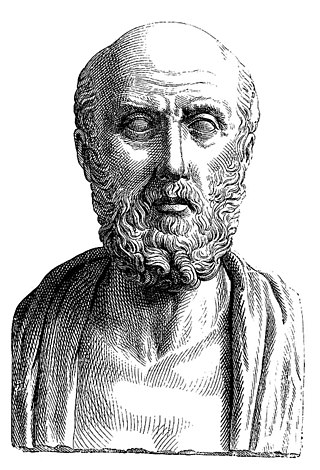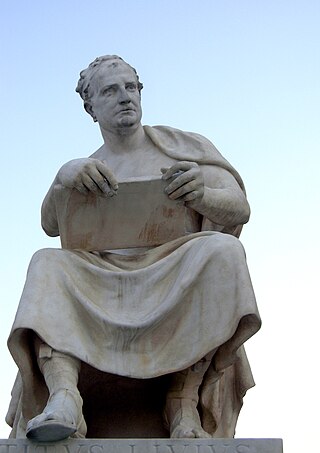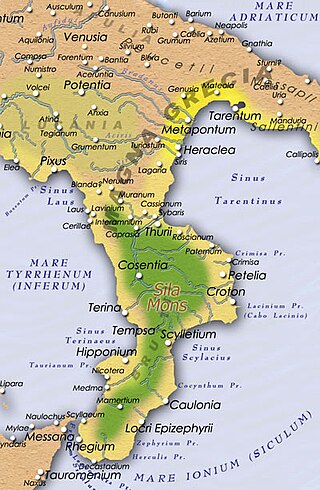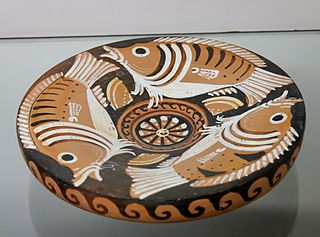Related Research Articles

Hippocrates of Kos, also known as Hippocrates II, was a Greek physician of the classical period who is considered one of the most outstanding figures in the history of medicine. He is traditionally referred to as the "Father of Medicine" in recognition of his lasting contributions to the field, such as the use of prognosis and clinical observation, the systematic categorization of diseases, or the formulation of humoral theory. The Hippocratic school of medicine revolutionized ancient Greek medicine, establishing it as a discipline distinct from other fields with which it had traditionally been associated, thus establishing medicine as a profession.

Titus Livius, known in English as Livy, was a Roman historian. He wrote a monumental history of Rome and the Roman people, titled Ab Urbe Condita, ''From the Founding of the City'', covering the period from the earliest legends of Rome before the traditional founding in 753 BC through the reign of Augustus in Livy's own lifetime. He was on good terms with members of the Julio-Claudian dynasty and was a friend of Augustus, whose young grandnephew, the future emperor Claudius, he encouraged to take up the writing of history.

A pandemic is an epidemic of an infectious disease that has spread across a large region, for instance multiple continents or worldwide, affecting a substantial number of individuals. Widespread endemic diseases with a stable number of infected individuals such as recurrences of seasonal influenza are generally excluded as they occur simultaneously in large regions of the globe rather than being spread worldwide.

An epidemic is the rapid spread of disease to a large number of hosts in a given population within a short period of time. For example, in meningococcal infections, an attack rate in excess of 15 cases per 100,000 people for two consecutive weeks is considered an epidemic.

The 1918 flu pandemic, also known as the Great Influenza epidemic or by the common misnomer of the Spanish flu, was an exceptionally deadly global influenza pandemic caused by the H1N1 influenza A virus. The earliest documented case was March 1918 in the state of Kansas in the United States, with further cases recorded in France, Germany and the United Kingdom in April. Two years later, nearly a third of the global population, or an estimated 500 million people, had been infected in four successive waves. Estimates of deaths range from 17 million to 50 million, and possibly as high as 100 million, making it one of the deadliest pandemics in history.

Encephalitis lethargica is an atypical form of encephalitis. Also known as "sleeping sickness" or "sleepy sickness", it was first described in 1917 by neurologist Constantin von Economo and pathologist Jean-René Cruchet. The disease attacks the brain, leaving some victims in a statue-like condition, speechless and motionless. Between 1915 and 1926, an epidemic of encephalitis lethargica spread around the world. The exact number of people infected is unknown, but it is estimated that more than one million people contracted the disease during the epidemic, which directly caused more than 500,000 deaths. Most of those who survived never returned to their pre-morbid vigour.

The Hippocratic Corpus, or Hippocratic Collection, is a collection of around 60 early Ancient Greek medical works strongly associated with the physician Hippocrates and his teachings. The Hippocratic Corpus covers many diverse aspects of medicine, from Hippocrates' medical theories to what he devised to be ethical means of medical practice, to addressing various illnesses. Even though it is considered a singular corpus that represents Hippocratic medicine, they vary in content, age, style, methods, and views practiced; therefore, authorship is largely unknown. Hippocrates began Western society's development of medicine, through a delicate blending of the art of healing and scientific observations. What Hippocrates was sharing from within his collection of works was not only how to identify symptoms of disease and proper diagnostic practices, but more essentially, he was alluding to his personable form of art, "The art of true living and the art of fine medicine combined." The Hippocratic Corpus became the foundation upon which Western medical practice was built.

Flu season is an annually recurring time period characterized by the prevalence of an outbreak of influenza (flu). The season occurs during the cold half of the year in each hemisphere. It takes approximately two days to show symptoms. Influenza activity can sometimes be predicted and even tracked geographically. While the beginning of major flu activity in each season varies by location, in any specific location these minor epidemics usually take about three weeks to reach its pinnacle, and another three weeks to significantly diminish.

The battle or, more precisely, the battles of Croton in 204 and 203 BC were, as well as the raid in Cisalpine Gaul, the last larger scale engagements between the Romans and the Carthaginians in Italy during the Second Punic War. After Hannibal’s retreat to Bruttium due to the Metaurus debacle, the Romans continuously tried to block his forces from gaining access to the Ionian Sea and cut his eventual escape to Carthage by capturing Croton. The Carthaginian commander struggled to retain his hold on the last efficient port which had remained in his hands after years of fighting and was ultimately successful.
Delium was a small town in ancient Boeotia with a celebrated temple of Apollo. It was located upon the sea-coast in the territory of Tanagra in Boeotia, and at the distance of about a mile from the territory of Oropus. This temple, which like the town took its name from the island of Delos, is described by Livy as overhanging the sea, and distant 5 miles (8.0 km) from Tanagra, at the spot where the passage to the nearest parts of Euboea is less than 4 miles (6.4 km). Strabo speaks of Delium as a temple of Apollo and a small town (πολίχνιον) of the Tanagraei, distant 40 stadia from Aulis.

The social history of viruses describes the influence of viruses and viral infections on human history. Epidemics caused by viruses began when human behaviour changed during the Neolithic period, around 12,000 years ago, when humans developed more densely populated agricultural communities. This allowed viruses to spread rapidly and subsequently to become endemic. Viruses of plants and livestock also increased, and as humans became dependent on agriculture and farming, diseases such as potyviruses of potatoes and rinderpest of cattle had devastating consequences.
Modern understanding of disease is very different from the way it was understood in ancient Greece and Rome. The way modern physicians approach healing of the sick differs greatly from the methods used by early general healers or elite physicians like Hippocrates or Galen. In modern medicine, the understanding of disease stems from the "germ theory of disease", a concept that emerged in the second half of the 19th century, such that a disease is the result of an invasion of a micro-organism into a living host. Therefore, when a person becomes ill, modern treatments "target" the specific pathogen or bacterium in order to "beat" or "kill" the disease.

Classical antiquity is the period of cultural history spanning from the 8th century BC to the beginning of the Middle Ages. The major civilizations are those of the Mediterranean region, ancient Greece, ancient Rome, and southwest Asia. Nutrition consisted of simple fresh or preserved whole foods that were either locally grown or transported from neighboring areas during times of crisis. Physicians and philosophers studied the effect of food on the human body and they generally agreed that food was important in preventing illness and restoring health.
This is a timeline of influenza, briefly describing major events such as outbreaks, epidemics, pandemics, discoveries and developments of vaccines. In addition to specific year/period-related events, there is the seasonal flu that kills between 250,000 and 500,000 people every year and has claimed between 340 million and 1 billion human lives throughout history.
Titus Veturius Geminus Cicurinus was a Roman politician of the 5th century BC, consul in 462 BC and maybe decemvir in 451 BC.
Publius Curiatius Fistus Trigeminus was a Roman politician in the 5th century BC, consul in 453 BC and decemvir in 451 BC.

The 2017–2018 United States flu season lasted from late 2017 through early 2018. The predominant strain of influenza was H3N2. During the spring months of March–May, influenza B virus became dominant.

In 1510, an acute respiratory disease emerged in Asia before spreading through North Africa and Europe during the first chronicled, inter-regional flu pandemic generally recognized by medical historians and epidemiologists. Influenza-like illnesses had been documented in Europe since at least Charlemagne, with 1357's outbreak the first to be called influenza, but the 1510 flu pandemic is the first to be pathologically described following communication advances brought about by the printing press. Flu became more widely referred to as coqueluche and coccolucio in France and Sicily during this pandemic, variations of which became the most popular names for flu in early modern Europe. The pandemic caused significant disruption in government, church, and society with near-universal infection and a mortality rate of around 1%.

In 1557, a pandemic strain of influenza emerged in Asia, then spread to Africa, Europe, and eventually the Americas. This flu was highly infectious and presented with intense, occasionally lethal symptoms. Medical historians like Thomas Short, Lazare Rivière and Charles Creighton gathered descriptions of catarrhal fevers recognized as influenza by modern physicians attacking populations with the greatest intensity between 1557 and 1559. The 1557 flu saw governments, for possibly the first time, inviting physicians to instill bureaucratic organization into epidemic responses. It is also the first pandemic where influenza is pathologically linked to miscarriages, given its first English names, and is reliably recorded as having spread globally. Influenza caused higher burial rates, near-universal infection, and economic turmoil as it returned in repeated waves.
Himilco was a Carthaginian general during the Second Punic War. He invaded Sicily in 214 BC, after the pro-Carthaginian tyrants Hippocrates and Epicydes came to power in Syracuse. With their assistance, and with a large Carthaginian army of 20,000 infantry and 3,000 cavalry, he overran large portions of Sicily, including the old Carthaginian stronghold of Agrigentum, and harried the Roman forces under Marcus Claudius Marcellus that were besieging Syracuse.
References
- ↑ Potter, C. W. (2002). "Foreword". Influenza. Elsevier Science. p. vii.
- ↑ Nelson, Kenrad E. (2001). Infectious Disease Epidemiology: Theory and Practice. Jones and Bartlett. p. 334.
- ↑ Hardman, Lizabeth (2011). Influenza Pandemics. Lucent Books. p. 8.
- 1 2 Hippocrates, Of the Epidemics, Book I
- ↑ Livy, The History of Rome, Book IV, 52, 3-5
- ↑ Livy, The History of Rome, Book IV, 52, 5-6